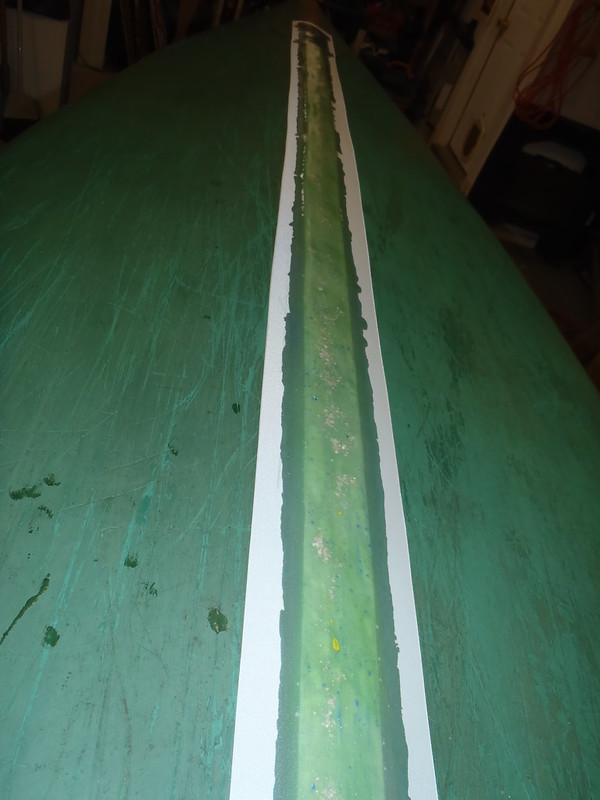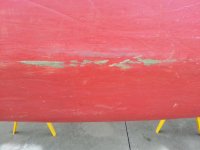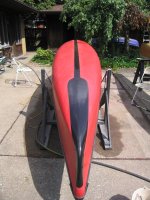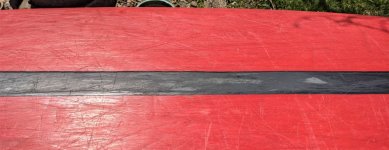-
Happy Mathematics Day! ❌📐♾️
You are using an out of date browser. It may not display this or other websites correctly.
You should upgrade or use an alternative browser.
You should upgrade or use an alternative browser.
Mad River Canoe - Been Nice to Know You
- Thread starter Mike McCrea
- Start date
- Joined
- Jul 6, 2021
- Messages
- 643
- Reaction score
- 1,174
There are sure to be Craigslist ads in 2023 touting “Made by the famous Mad River Canoe company, the no longer available Adventure 16, only 85lbs including twelve cup holders”
I do wonder how many Explorers were made in total, counting Royalex, glass and various kevlar models. The Explorer was fine do-everything canoe, thankfully not unicorns on the used market.
I do wonder how many Explorers were made in total, counting Royalex, glass and various kevlar models. The Explorer was fine do-everything canoe, thankfully not unicorns on the used market.
It’s my impression that, as Mike noted so eloquently, love of canoes seems bounded to the older generation. I’m not 50 yet, but not “one of the kids” anymore; the divide is wide as far as I’m concerned. That said, as far as I know all the great designers are also long in the tooth. As are many of the builders. Do y’all get any sense that there is a next generation in the wings ready to keep things moving?
Call me an optimist, but I do see some hope. I was at a canoe race last weekend, and looking at the results by class (High School, Jr/Sr, etc) I count approx 35 minors. Those kids will go to college and forget about all this stuff, then move to the big city and work and slave for reasons they will later have trouble articulating, but finally around 2040 or 2045 they'll see a canoe on top of somebody else's car and wish they were on the water. And, because they slogged down the Passagassawaukeag River a few times with their schoolmates they will know what to do. Will there be enough of them to replace the crusty old canoeists who won't make it to 2040? Probably not, but my sense is that canoeing has more demographic hope than many other traditional activities.
Jim sold MRC to Kay in 1987. He was not involved in the sale to Confluence.“I recall hearing in the '80's from an industry source who knew all the players personally, how Jim Henry would proclaim (perhaps when slightly lubricated) that he would bury Old Town. Well, OT isn't yet buried but they are only a skeleton of what they once were—now pumping out only a relatively few cheap, heavy, plastic open canoes, along with heavy plastic kayaks.”
I can’t blame owners for taking a buyout when the getting out is good, perhaps excepting private equity firms with no canoe skin in the game.
I hope Jim (Kay?) Henry got a decent price from Confluence. I believe some of the canoe manufacturers gone-by received dang little; thinking of Sawyer, or more recent small niche builders who have folded, sold or are wanting to sell with no White Knight buyer appearing.
What does Old Town Canoe, eh, I mean Old Town Canoe & Kayak, still make canoe wise? Naught but a few heavy poly hulls.
https://oldtowncanoe.johnsonoutdoor...3.2095646802.1649357133-1272925554.1649357133
The end of OT canoes may not be nigh, but there is nothing in that line I would care to own.
“some people just can’t beat the prices of a kayak/canoe from Costco”
Playing the foil once again, if a $200 big-box rec SOT or sit-in, with paddle included, gets folks started, and they become advocates for access and clean water, well, I guess I can live with that.
A bunch of geriatric old farts, barely able to get in and out of a canoe, however vocal, do not a future make.
Jim sold MRC to Kay in 1987. He was not involved in the sale to Confluence.
Nhdecoy, welcome to site membership!
- Joined
- Mar 16, 2017
- Messages
- 256
- Reaction score
- 426
Well that red canoe I just finished rebuilding for the third time is the hallowed 42# Mad River kevlar Explorer, which indeed does make a fine solo tripper, especially if you like poling. I bought it for a case of beer and a hundred dollars from a feller in Greenville who contacted me out of the blue, felt I should have it. It underwent massive plastic surgery at Doug's Humble Hovel. I still have the classic "Handbasket Class" Royalex Explorer, a kevlar Malecite and a kevlar TW Special. Not to mention a Bell Mystic and a Sawyer Shockwave.
Mad River has been going down hill for a while. A friend tried my Malecite, liked it, and ordered a brand new one. There was a good five extra pounds of gel coat on it, so thick it cracked before she even put it in the water. She returned it for a replacement, just as bad, finally just returned it for cash.
Mad River has been going down hill for a while. A friend tried my Malecite, liked it, and ordered a brand new one. There was a good five extra pounds of gel coat on it, so thick it cracked before she even put it in the water. She returned it for a replacement, just as bad, finally just returned it for cash.
So those of you who wistfully remember the MR of yore, what is your impression of the shallow-V hull design? I've spent little time in them, mostly being a Old Town Penobscot/Wenonah fast boats shallow arch kind of guy. I have a Royalex Courier, but I've spent almost 0 time in it, and only on flat water (where it sucks from my perspective, but I bought it for the local rocky rivers).
The shallow V design is OK but I don't think it has any real advantages over a shallow arch design. The oft-mentioned beneficial effect on tracking is rather miniscule IMO. The shallow V contour does increase wetted surface area and drag a bit. Also, when the canoe is stationary the hull has a tendency to want to tip slightly onto one of the "flats". While this is no big deal at all it can be a little disconcerting to someone unfamiliar with the design. The shallow V also tends to concentrate hull wear from abrasion in shallow rocky water to a narrow strip down the centerline of the canoe.
I agree with what pblanc wrote, but would add that heeling the shallow V onto the "flats"—e.g., when turning or paddling heeled Canadian solo style in a tandem—perhaps provides a slightly more solid secondary stability feel than the same canoe with a shallow arch bottom would. I can't prove that, since I've never paddled two canoes that were identical other than a shallow V versus a shallow arch bottom. However, I just always felt a lot of secondary stability in MRC shallow V canoes.
- Joined
- Jul 6, 2021
- Messages
- 643
- Reaction score
- 1,174
“The shallow V design is OK but I don't think it has any real advantages over a shallow arch design.
Also, when the canoe is stationary the hull has a tendency to want to tip slightly onto one of the "flats". While this is no big deal at all it can be a little disconcerting to someone unfamiliar with the design. The shallow V also tends to concentrate hull wear from abrasion in shallow rocky water to a narrow strip down the centerline of the canoe”
We have both shallow V and shallow arch bottomed canoes. I don’t notice a lot of primary stability difference, although I am heavy enough, and carry enough gear even on day trips, that the waterline depth usually extends below the shallow vee.
The abrasion focused along the apex of the vee is an issue, especially on older MRC’s run hard in shallow waters.
 PC210004 by Mike McCrea, on Flickr
PC210004 by Mike McCrea, on Flickr
Time may eventually come time for shallow vee repairs; nothing as handy as a long, linear abrasion resistant strip of Dynel sleeve, compressed under peel ply.
 PC290010 by Mike McCrea, on Flickr
PC290010 by Mike McCrea, on Flickr
“I agree with what pblanc wrote, but would add that heeling the shallow V onto the "flats"—e.g., when turning or paddling heeled Canadian solo style in a tandem—perhaps provides a slightly more solid secondary stability feel than the same canoe with a shallow arch bottom would.”
I am curious about the shallow vee’s usefulness as a poling canoe. A fair number of polers I know use MRC Explorers as their poling canoe of choice.
I don’t know if that is based on the Explorer’s availability, or if the shallow vee offers advantages when standing tall with pole in hand. ???
Also, when the canoe is stationary the hull has a tendency to want to tip slightly onto one of the "flats". While this is no big deal at all it can be a little disconcerting to someone unfamiliar with the design. The shallow V also tends to concentrate hull wear from abrasion in shallow rocky water to a narrow strip down the centerline of the canoe”
We have both shallow V and shallow arch bottomed canoes. I don’t notice a lot of primary stability difference, although I am heavy enough, and carry enough gear even on day trips, that the waterline depth usually extends below the shallow vee.
The abrasion focused along the apex of the vee is an issue, especially on older MRC’s run hard in shallow waters.
 PC210004 by Mike McCrea, on Flickr
PC210004 by Mike McCrea, on FlickrTime may eventually come time for shallow vee repairs; nothing as handy as a long, linear abrasion resistant strip of Dynel sleeve, compressed under peel ply.
 PC290010 by Mike McCrea, on Flickr
PC290010 by Mike McCrea, on Flickr“I agree with what pblanc wrote, but would add that heeling the shallow V onto the "flats"—e.g., when turning or paddling heeled Canadian solo style in a tandem—perhaps provides a slightly more solid secondary stability feel than the same canoe with a shallow arch bottom would.”
I am curious about the shallow vee’s usefulness as a poling canoe. A fair number of polers I know use MRC Explorers as their poling canoe of choice.
I don’t know if that is based on the Explorer’s availability, or if the shallow vee offers advantages when standing tall with pole in hand. ???
Thanks guys. That's pretty much what I've experienced and expected. The PR the Henrys put out 40 years ago when I was selling the competition didn't make sense then, and it still doesn't. Back then it was Old Town and Mad River (and Blue Hole??). I'd think the Explorer was a good seller since it wasn't as big as a Tripper, and more efficient and available than an OCA. Who knows?
This old MRC ME had quite a bit of stem wear in addition to a stripe of wear down the midline V amidships where the canoe has the greatest draft. The abrasion was not quite into the foam core but it was getting close in places and the outer solid layer of ABS was markedly thinned out.

In addition to stem abrasion plates of 5 ounce/square yard plain weave Dynel I applied a full length keel strip of the same material down the full length of the hull bottom.


In addition to stem abrasion plates of 5 ounce/square yard plain weave Dynel I applied a full length keel strip of the same material down the full length of the hull bottom.

Since those photos of the ME were taken right after I repaired it, the boat has been paddled pretty extensively on shallow, rocky whitewater rivers like the Nanatahala in NC, the Hiwassee in TN and the Slippery Rock Creek in PA, as well as on multiple trips on gravel bottom shallow Ozark rivers in Southern Missouri and northern Arkansas. As it happens I have the boat in the back yard today for some preventative maintenance getting ready to apply another coat of West System epoxy/graphite powder mixture to some areas of wear along the keel strip as shown in the photos below. There is virtually no wear of significance to the abrasion plates except a couple of minor scratches but as can be seen the significant wear is on the keel strip amidships. The fibers of the Dynel fabric are becoming exposed and just starting to get abraded in a couple of areas.




- Joined
- Jul 6, 2021
- Messages
- 643
- Reaction score
- 1,174
“As it happens I have the boat in the back yard today for some preventative maintenance getting ready to apply another coat of West System epoxy/graphite powder mixture to some areas of wear along the keel strip as shown in the photos below. There is virtually no wear of significance to the abrasion plates except a couple of minor scratches but as can be seen the significant wear is on the keel strip amidships. The fibers of the Dynel fabric are becoming exposed and just starting to get abraded in a couple of areas”
Pete, much the same occasional maintenance with various routinely abused vee bottoms.
It takes a while, certainly much longer than with glass tape, but when our vee bottom hulls get to abrading or scraping up the Dynel it is easy enough to re-tape and lay another coat of epoxy mixed with graphite powder atop.
I do like that topcoat treatment with graphite powder and some G/flex in the epoxy mix. Since I don’t need to epoxy to saturate the Dynel fabric maybe a little heavier on the G/flex than the usual mixing ratio with 105/206.
The keel line strip, being straight edged, is easy to tape.
Pete, much the same occasional maintenance with various routinely abused vee bottoms.
It takes a while, certainly much longer than with glass tape, but when our vee bottom hulls get to abrading or scraping up the Dynel it is easy enough to re-tape and lay another coat of epoxy mixed with graphite powder atop.
I do like that topcoat treatment with graphite powder and some G/flex in the epoxy mix. Since I don’t need to epoxy to saturate the Dynel fabric maybe a little heavier on the G/flex than the usual mixing ratio with 105/206.
The keel line strip, being straight edged, is easy to tape.
Sorry hear this.
As I long time attendee of Canoecopia in Madison WI each spring I witnessed the steady onslaught of kayaks over open canoes. I first went to a meet-the-maker one-day event at the old Rutabaga shop on Monroe St in the late 1970’s. Not long after, the shop moved the show to the Expo Center and the show got bigger every year. I have attended every show from 1984 to start of the pandemic. I have worked at the show 4-5 times in recent years and I quit responding to the calls over the PA system to come and help unload boats as they were brought to the show venue during set-up - it was tall boat trailer after trailer of HEAVY poly kayaks. Very few canoes. I remember many years of a large center exhibition space for MR. Now the only similar large canoe display is Wenonah. And the canoe displays seemed to be populated by mostly old guys. Sad.
As I long time attendee of Canoecopia in Madison WI each spring I witnessed the steady onslaught of kayaks over open canoes. I first went to a meet-the-maker one-day event at the old Rutabaga shop on Monroe St in the late 1970’s. Not long after, the shop moved the show to the Expo Center and the show got bigger every year. I have attended every show from 1984 to start of the pandemic. I have worked at the show 4-5 times in recent years and I quit responding to the calls over the PA system to come and help unload boats as they were brought to the show venue during set-up - it was tall boat trailer after trailer of HEAVY poly kayaks. Very few canoes. I remember many years of a large center exhibition space for MR. Now the only similar large canoe display is Wenonah. And the canoe displays seemed to be populated by mostly old guys. Sad.
There is virtually no wear of significance to the abrasion plates except a couple of minor scratches but as can be seen the significant wear is on the keel strip amidships.
Pete, much the same occasional maintenance with various routinely abused vee bottoms.
Wear primarily in the center bottom of solo canoes, most especially highly rockered solo whitewater canoes, is common. All my whitewater solos wear first under the solo seat, especially if that seat is a saddle jammed under thwarts, which prevents bottom flex.
I wouldn't attribute this amidships wear phenomenon particularly to a shallow V bottom. Although the center wear will certainly show first along the ridge of the V, it shows up in the same place on my arched and flattish bottomed whitewater canoes, too. The bottom center is where the rock-scraping deepest draft is, as Pete says, and also because the ends are highly rockered, which gets the stems further away from abrasive geology.
Wear primarily in the center bottom of solo canoes, most especially highly rockered solo whitewater canoes, is common. All my whitewater solos wear first under the solo seat, especially if that seat is a saddle jammed under thwarts, which prevents bottom flex.
I wouldn't attribute this amidships wear phenomenon particularly to a shallow V bottom. Although the center wear will certainly show first along the ridge of the V, it shows up in the same place on my arched and flattish bottomed whitewater canoes, too. The bottom center is where the rock-scraping deepest draft is, as Pete says, and also because the ends are highly rockered, which gets the stems further away from abrasive geology.
Agree with all you said. Shallow arch solo hulls with a lot of rocker will also show wear amidships centered under the paddler's weight. But I have found that with shallow arch hulls the wear is a bit more diffuse. The shallow V hulls tend to concentrate the wear to a very narrow strip which tends to make the outer solid layer of ABS in a Royalex boat wear through a bit more quickly.
- Joined
- Jul 6, 2021
- Messages
- 643
- Reaction score
- 1,174
“Wear primarily in the center bottom of solo canoes, most especially highly rockered solo whitewater canoes, is common. All my whitewater solos wear first under the solo seat, especially if that seat is a saddle jammed under thwarts, which prevents bottom flex.”
That is certainly true of heavily rockered WW solos.
I will admit, even confess, that the stems of our tripping canoes are the first place to show worrisome wear.
“Confess” because I do sometimes drive the bow ashore when wind, wave and water depth makes that an easier option than coming in sideways and wet footing over the side.
And “confess” that the worn sterns are in part from me dragging the canoe ashore for short distances. And in part because I like my canoes trimmed a little bow light, so the stern, skegged a bit, is the area that first grumbles across a not quite deep enough shallows.
On our shallow vee boats the center wear does concentrate at the apex of the vee, on our shallow arch or even flattish bottomed hulls the centered bottom scratches are more diffuse.
That is certainly true of heavily rockered WW solos.
I will admit, even confess, that the stems of our tripping canoes are the first place to show worrisome wear.
“Confess” because I do sometimes drive the bow ashore when wind, wave and water depth makes that an easier option than coming in sideways and wet footing over the side.
And “confess” that the worn sterns are in part from me dragging the canoe ashore for short distances. And in part because I like my canoes trimmed a little bow light, so the stern, skegged a bit, is the area that first grumbles across a not quite deep enough shallows.
On our shallow vee boats the center wear does concentrate at the apex of the vee, on our shallow arch or even flattish bottomed hulls the centered bottom scratches are more diffuse.
A few years back I did volunteer work for a conservation society that ran canoe outings on a local creek and local lakes. They had a fleet of Royalex canoes which were of pretty good quality, mostly molded by Dagger, Bell, and Wenonah with some rebranded and sold by Galyans (Woodsmans). I did most of the maintenance work on these boats.“Wear primarily in the center bottom of solo canoes, most especially highly rockered solo whitewater canoes, is common. All my whitewater solos wear first under the solo seat, especially if that seat is a saddle jammed under thwarts, which prevents bottom flex.”
That is certainly true of heavily rockered WW solos.
I will admit, even confess, that the stems of our tripping canoes are the first place to show worrisome wear.
“Confess” because I do sometimes drive the bow ashore when wind, wave and water depth makes that an easier option than coming in sideways and wet footing over the side.
And “confess” that the worn sterns are in part from me dragging the canoe ashore for short distances. And in part because I like my canoes trimmed a little bow light, so the stern, skegged a bit, is the area that first grumbles across a not quite deep enough shallows.
On our shallow vee boats the center wear does concentrate at the apex of the vee, on our shallow arch or even flattish bottomed hulls the centered bottom scratches are more diffuse.
Despite our best efforts to prevent clients from doing so, it was pretty common practice for them to ground the bow stems of these boats onto concrete boat ramps to disembark. Of course, that happened only once or twice for each boat on each excursion. Otherwise the creek we paddled had a soft muddy bottom.
It was quite surprising how quickly that mistreatment resulted in pretty serious wear concentrated in a small strip about 3 inches or so in length and less than an inch in width right where the bow stem grated on the concrete. It was not unusual for these boats to have erosion into the foam core at that location. That happened within a couple of years despite the fact that these boats were used only 50 times a year or thereabouts.
Last edited:
Similar threads
- Replies
- 0
- Views
- 714
- Replies
- 13
- Views
- 7K
